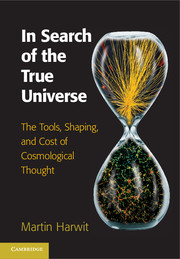Book contents
- Frontmatter
- Contents
- Preface
- Notes on Usage
- 1 The Nineteenth Century's Last Five Years
- Part I The Import of Theoretical Tools
- Part II A National Plan Shaping the Universe We Perceive
- 7 A New Order and the New Universe It Produced
- 8 Where Did the Chemical Elements Arise?
- 9 Landscapes
- 10 The Evolution of Astrophysical Theory after 1960
- 11 Turmoils of Leadership
- 12 Cascades and Shocks that Shape Astrophysics
- 13 Astrophysical Discourse and Persuasion
- Part III The Cost of Discerning the True Universe
- Epilogue
- Appendix: Symbols, Glossary, Units and Their Ranges
- Index
- References
13 - Astrophysical Discourse and Persuasion
Published online by Cambridge University Press: 05 December 2013
- Frontmatter
- Contents
- Preface
- Notes on Usage
- 1 The Nineteenth Century's Last Five Years
- Part I The Import of Theoretical Tools
- Part II A National Plan Shaping the Universe We Perceive
- 7 A New Order and the New Universe It Produced
- 8 Where Did the Chemical Elements Arise?
- 9 Landscapes
- 10 The Evolution of Astrophysical Theory after 1960
- 11 Turmoils of Leadership
- 12 Cascades and Shocks that Shape Astrophysics
- 13 Astrophysical Discourse and Persuasion
- Part III The Cost of Discerning the True Universe
- Epilogue
- Appendix: Symbols, Glossary, Units and Their Ranges
- Index
- References
Summary
Given the unruly onset of cascades described in the last chapter, how can we ever be sure whether our investigations are yielding a credible picture of the Universe? What warning signs should we look for to determine whether our pursuit may merely lead to a construct, potentially accounting for all available observations but nonetheless a mere caricature of the Cosmos – rather than a true portrait?
Language and Its Role in Persuasion
Astrophysics progresses through persuasion. Astronomers need to convince each other of the reality of a new finding. A discovery that fails to persuade colleagues goes nowhere. Once the astronomical community is convinced, it has to also persuade funding agencies of the discovery's importance.
Neither step is easy. Researchers investigating planetary systems, the structure and evolution of stars, the chemistry of interstellar dust and gases, the formation of galaxies, and the birth and evolution of the Cosmos all express themselves using slightly, but nevertheless significantly differing vocabularies. A clear exchange of ideas among the members of different disciplines, however, requires those vocabularies to be well defined and mutually understood. In practice this is rare. Words assume new meanings as novel findings in a discipline enrich a concept. The connotations of identical expressions used in different disciplines then gradually diverge, so that misunderstandings easily arise and dialogue suffers.
- Type
- Chapter
- Information
- In Search of the True UniverseThe Tools, Shaping, and Cost of Cosmological Thought, pp. 290 - 306Publisher: Cambridge University PressPrint publication year: 2013



